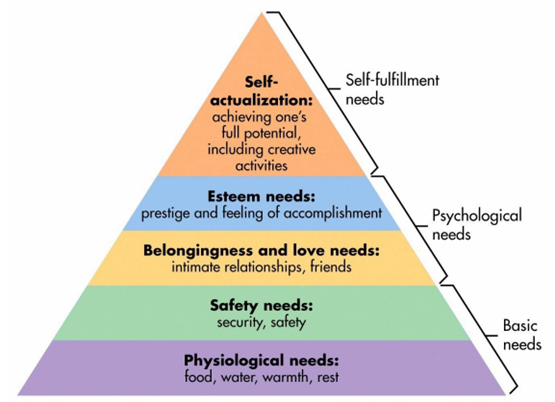Maslow's Hierarchy of Needs
Maslow’s Hierarchy of Needs is a psychological theory about motivation, which categorizes human needs into five-tier model in the form of a pyramid, that should be fulfilled from bottom-up. These five tiers are physiological needs, safety needs, belongingness and love need, esteem needs, and self-actualization.

- Physiological Needs
Physiological needs are the most basic biological requirements needed for human survival. These needs are required in order for the human body to be able to function optimally. Examples of these needs include, food, drink, warmth, clothing, shelter, sleep, etc.
- Safety Needs
Safety needs is on the second tier of Maslow’s Hierarchy of Needs. This kind of needs refers to how humans seek for protection from law, security, stability and be free from fear.
- Belongingness and Love Needs
The third tier is the need for human to be social and receives the feeling of belongingness, as well as the need to have interpersonal relationships. Examples of these needs include, friendship, affiliations, intimacy, trust, sharing affections, etc.
- Esteem Needs
This need is separated into two categories. First is the esteem for oneself, which include dignity, achievement, independence, etc. The second one is the desire for reputation or respect from others, such as status and prestige.
- Self-Actualization
This stage shows growth. This is the point where one will realize their personal potential, self-fulfilment, seek for personal growth and peak experience. At this point, a person will have the desire “to become everything one is capable of becoming.”
The first four levels in the pyramid are also known as deficiency needs, or D-needs. And the highest tier of the pyramid is known as growth or being needs, B-needs.

Deficiency needs usually appear when there is deprivation and will motivate people when the needs were not fulfilled. This kind of need will motivate people even more, the longer it is ignored and not fulfilled. For example, the longer a person goes without eating, they will become hungrier. When the deficiency needs are more-or-less fulfilled, people will then tend to continue to feel the need to satisfy the next set of needs.
Meanwhile, growth is different. It isn’t rooted from deprivation, but appears due to the desire of an individual to grow. Additionally, growth will continue as long as one has the desire for it. When the growth needs are fulfilled, one will reach the level of self-actualization.
However, every individual will not have a smooth progress of simply fulfilling the needs and going up the next level. In life, there may be a lot of events that can disrupt the fulfilment of the lower-level needs, such as divorce, deaths, and other events. Hence, the movement between the tiers will not be in a one-direction upwards, instead it is fluctuating and one will move back and forth between the different types of needs.
The five-stage model of Maslow’s Hierarchy of Needs also has an expansion which leads into eight-stage model of Maslow’s Motivation Model. The eight-stage model includes, biological and physiological needs, safety needs, love and belongingness needs, esteem needs, cognitive needs, aesthetic needs, self-actualization needs, and transcendence needs.

While, the five similar stages enclosed the same kind of needs, there are 3 other stages covered in Maslow’s Motivation Model.
- Cognitive Needs
Cognitive needs involve the desire to gain knowledge and understanding, the desire to explore, to be curious, as well as the need for meaning and predictions.
- Aesthetic Needs
Aesthetic needs involve the act of appreciation and attraction towards beauty, form, and balance.
- Transcendence Needs
Transcendence needs involve motivation for people that goes beyond an individual self, such as experiences in nature, religious faith, service to others, etc.
SDG: 4 Quality education.


Comments :